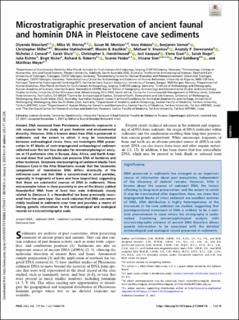| dc.contributor.author | Massilani, Diyendo | |
| dc.contributor.author | Morley, Mike W. | |
| dc.contributor.author | Mentzer, Susan M. | |
| dc.contributor.author | Aldeias, Vera | |
| dc.contributor.author | Vernot, Benjamin | |
| dc.contributor.author | Miller, Christopher | |
| dc.contributor.author | Stahlschmidt, Mareike | |
| dc.contributor.author | Kozlikin, Maxim B. | |
| dc.contributor.author | Shunkov, Michael V. | |
| dc.contributor.author | Derevianko, Anatoly P. | |
| dc.contributor.author | Conard, Nicholas J. | |
| dc.contributor.author | Wurz, Sarah Jacoba Deborah | |
| dc.contributor.author | Henshilwood, Christopher Stuart | |
| dc.contributor.author | Vasquez, Javi | |
| dc.contributor.author | Essel, Elena | |
| dc.contributor.author | Nagel, Sarah | |
| dc.contributor.author | Richter, Julia | |
| dc.contributor.author | Nickel, Birgit | |
| dc.contributor.author | Roberts, Richard G. | |
| dc.contributor.author | Paabo, Svante | |
| dc.contributor.author | Slon, Viviane | |
| dc.contributor.author | Meyer, Matthias | |
| dc.contributor.author | Goldberg, Paul | |
| dc.date.accessioned | 2023-01-04T13:18:28Z | |
| dc.date.available | 2023-01-04T13:18:28Z | |
| dc.date.created | 2022-05-10T12:34:28Z | |
| dc.date.issued | 2022 | |
| dc.identifier.issn | 0027-8424 | |
| dc.identifier.uri | https://hdl.handle.net/11250/3040971 | |
| dc.description.abstract | Ancient DNA recovered from Pleistocene sediments represents a rich resource for the study of past hominin and environmental diversity. However, little is known about how DNA is preserved in sediments and the extent to which it may be translocated between archaeological strata. Here, we investigate DNA preservation in 47 blocks of resin-impregnated archaeological sediment collected over the last four decades for micromorphological analyses at 13 prehistoric sites in Europe, Asia, Africa, and North America and show that such blocks can preserve DNA of hominins and other mammals. Extensive microsampling of sediment blocks from Denisova Cave in the Altai Mountains reveals that the taxonomic composition of mammalian DNA differs drastically at the millimeter-scale and that DNA is concentrated in small particles, especially in fragments of bone and feces (coprolites), suggesting that these are substantial sources of DNA in sediments. Three microsamples taken in close proximity in one of the blocks yielded Neanderthal DNA from at least two male individuals closely related to Denisova 5, a Neanderthal toe bone previously recovered from the same layer. Our work indicates that DNA can remain stably localized in sediments over time and provides a means of linking genetic information to the archaeological and ecological records on a microstratigraphic scale. | en_US |
| dc.language.iso | eng | en_US |
| dc.publisher | National Academy of Sciences | en_US |
| dc.rights | Navngivelse 4.0 Internasjonal | * |
| dc.rights.uri | http://creativecommons.org/licenses/by/4.0/deed.no | * |
| dc.title | Microstratigraphic preservation of ancient faunal and hominin DNA in Pleistocene cave sediments | en_US |
| dc.type | Journal article | en_US |
| dc.type | Peer reviewed | en_US |
| dc.description.version | publishedVersion | en_US |
| dc.rights.holder | Copyright 2022 The Author(s) | en_US |
| dc.source.articlenumber | e2113666118 | en_US |
| cristin.ispublished | true | |
| cristin.fulltext | original | |
| cristin.qualitycode | 2 | |
| dc.identifier.doi | 10.1073/pnas.2113666118 | |
| dc.identifier.cristin | 2023070 | |
| dc.source.journal | Proceedings of the National Academy of Sciences of the United States of America | en_US |
| dc.relation.project | Norges forskningsråd: 262618 | en_US |
| dc.identifier.citation | Proceedings of the National Academy of Sciences of the United States of America. 2022, 119 (1), e2113666118. | en_US |
| dc.source.volume | 119 | en_US |
| dc.source.issue | 1 | en_US |

